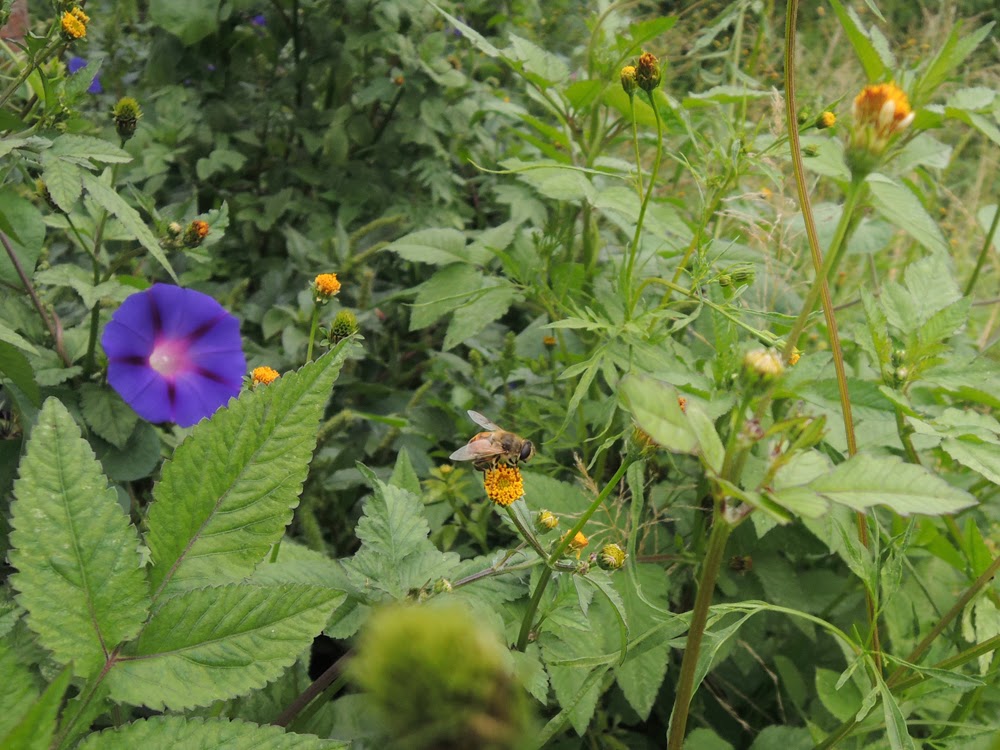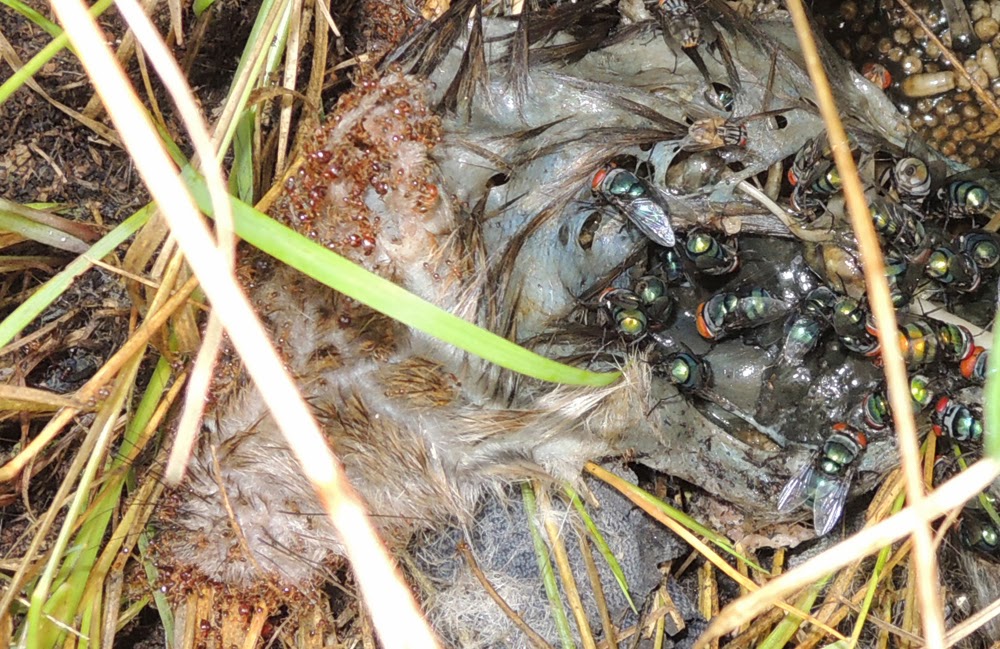Photos generously supplied by Francis Burger.
 |
| A Garden Orb-web Spider (Argiope australis). This spider was capitalising on the many flies of the city. |
When I think of a city urban space in Johannesburg, I see
concrete, tar roads, steel and a lot dirt, filth and stagnant water. The life I
would associate with these spaces would consist of street trees (sterile
imports from the northern hemisphere), Pigeons (properly Columbo livia, a cosmopolitan species from the northern
hemisphere), the odd house sparrow, rats and cockroaches (all three also
imports from the northern hemisphere. My skepticism concerning the ability of
nature to be robust enough to not only cling on in the city, but actually
thrive, was challenged this February while working with artist Francis Burger
on a project working in the city exploring biodiversity.
 |
| This small beetle was found on some grass growing on the verge. Even the smallest areas should not be underestimated as habitats for organisms. |
During two qualitative sessions, we walked the streets and
explores empty lots between buildings to try and build up an as comprehensive
species list, kind of like a snapshot, of what is out there in the city. Our
idea at first was to concentrate on grasses, but we soon found ourselves unable
to ignore the rich forb diversity. As we progressed we added insects and birds
as well as a reptile. After reviewing the findings I really had to face up to
my prejudices of what I thought these kinds of environments are able to
support.
 |
| Three species of beetles from the Coccinellinae sub-family. Many of these beetles are predatory and eat aphids. |
 |
|
Astylus
atromaculatus – Spotted Maize
Beetle. Native to South America this is a major agricultural pest.
|
Grass
Johannesburg is often referred to as the largest man-made
forest in the world. Many trees were planted in the early days of the city for
mining timber. The forest is here and it has changed the environment. In many
ways it is a good thing, but Johannesburg should actually be grassland. This
can be seen wherever trees and land has been cleared; the grass just comes up.
 |
| Inflorescence of Hyparrhenia hirta. An important grass for thatching. Some people were busy harvesting the very grass pictured here. |
 |
| Chloris pycnothrix or Spider-web Grass. |
 |
|
Eragrostis curvula.
|
One of the most amazing things about the growth of grass in
the city is that it tries to colonise any bit of ground it gets its seeds into.
Grass was found growing on pavements, between the pavers and in some areas in
the middle of the road. The ecological role of grass as a weathering agent can
clearly be seen. Everywhere it appears to be forcing cracks in the surface of
the city open for more plants to get in and continue the process.
 |
| Grass growing in the road. This grass will increase the gap that is already present and allow more organisms a space in what was once an inhabitable surface. |
Aliens vegetation and
their ecological roles
 |
| Cannabis sativa and Amaranthus hybridus. Both of these plants are important in human culture. Here they are playing the role of pioneer species. |
 |
| Here there are three dominant pioneer species: Bidens pilosa (Black Jacks), Tagetes minuta (Khaki Bos) and Ipomoea purpurea (Morning Glory). |
Wherever one looks in the city, the ratio between indigenous
plants and alien plants is skewed in favour of the aliens. This is to be
expected as these alien plants are supported by human activities and they are
among the most robust plants out there. These aliens are often found growing in
very trying conditions and usually unaffected by parasites and natural enemies
as they have evolved in a different ecological climate. In addition to these
factors the alien plants that are dominating growth areas are usually very fast
growing and spread very easily.
 |
|
Cuscuta sp. – Dodder
is a fascinating, yet very destructive weed. The plant is parasitic and wraps
itself around other plants while disconnecting itself from the ground and feeding
directly off its hosts. The plant is yellow and this is because it does not
even produce its own chlorophyll for photosynthesis.
|
 |
| Bidens pilosa and Ipomoea purpurea, two South American species growing together. |
Even though many of these plants are hated and seen as weeds
that need to be eradicated, they do serve a very important purpose in the
greater ecological scheme of things: these are the pioneers. This means they
are the first plants to colonise a piece of land that has been disturbed. They
often have roots that have nitrogen-fixing bacterial nodes on them and these
strengthen the soil. The pioneer species make way for secondary succession to
take place and after a few years their numbers will decline and different
plants will replace them. In the case of what was observed in Johannesburg, the
pioneers were mostly Tagetes minuta (Khaki
Bos) and Bidens pilosa (Black Jack).
 |
|
Trachylepis punctatissima – Speckled Rock Skink basking.
|
Lizards!
I was very pleased to find reptiles in the city. These were
represented by Speckled Rock Skinks (Trachylepis
punctatissima). These skinks are very robust and indicate that there is not
an overuse of insecticides and they also indicate a low population of cats,
which usually decimate their populations. At least eleven individuals were
observed and there may be as many as triple that amount that was not seen.
 |
| Another Speckled Rock Skink, this one is resting on a strange arrangement of bricks and wire suspended from the ground. |
Birds
Birds are a good indication of the state of an environment.
This is because they are not restricted by barriers that are faced by
terrestrial animals, they can leave and enter areas as they need to. Although
the amount of birds in the area is very low, it was higher than I had expected it
to be. But when compared to a preserved site in the same city, the species
diversity is very low. In the Klipriviersberg Nature Reserve for example, I
could get a list of 50 birds on an average day, my list for Jeppe for was 14
birds and some fly-overs. Below is the bird list in order of recording:
Tawny-flanked Prinia, Grey Go-away Bird, Cape Turtle Dove, Laughing Dove, Speckled Pigeon, Rock Dove, Indian Myna, Cape Glossy Starling, Cape Sparrow, House Sparrow, Karroo Thrush, Village Weaver, Grey Heron (fly-over), Green Wood-hoopoe, White Stork (fly-over), Reed Cormorant (fly-over), Barn Swallow and Little Swift.
Rats and beetles
Walking in town and looking in the growth of pavements and in gutters for signs of life one finds many dead rats. In any city rats are very successful and Johannesburg is no exception. Everywhere there were rat corpses in various stages of decomposition, most of them poisoned and some killed in the road by vehicles (although being killed by a car could be indirectly linked to being poisoned as the toxins often change the rats behaviors making them more susceptible to being ‘caught out’ in the open.
The investigation of the rat’s decomposing corpses revealed
an ecosystem on a small scale. Dermestidae
beetles were found on the bodies and so were flies (Calliphoridae) and their larvae. Feeding on the larvae were hister beetles
(Histeridae). The smell of bacteria
was also present. These organisms fulfill a very important role in the
decomposition process. Most people become queasy when confronted with a carcass
blooming with flies and maggots, but if those people could imagine a world
without flies and maggots they would feel far more sick.
Looking at how these species are able to survive in what
would seem to be adverse situations, I cant imagine what kind of animals would
be able to live in a city that provides some kind of ecological support
structures. Imagine rooftop gardens with locally indigenous plants, massive
containers with grass growing in them and ponds. My vision is one of islands of
natural vegetation where insects and birds can flourish. The amount of
diversity that can be attracted in such a scenario would be astounding. We are
a long way from that vision, but I feel the first step in that direction is to become
more aware of locally indigenous life and try and cultivate plants that are
locally indigenous to encourage organisms to make our cities their homes too.





No comments:
Post a Comment